Hyundai Staria vs Mercedes V Class – Which one offers the better deal?
Compare performance, boot capacity, efficiency and price at a glance.
Find out which car is the better choice for you – Hyundai Staria or Mercedes V Class?
Hyundai Staria vs. Mercedes V-Klasse: The Ultimate Van Showdown
In an ever-evolving automotive landscape, the battle of family vans remains fierce. Today, we compare two strong contenders in the segment: the Hyundai Staria and the Mercedes V-Klasse. Each vehicle comes with its unique set of features, engine options, and technical innovations, appealing to different expectations and needs. Let's dive deeper into their specifications, technical aspects, and innovations.
Design and Space
The Hyundai Staria makes a bold statement on the road with its futuristic design characterized by smooth lines and a sleek profile. The elongated form provides generous interior space, accommodating up to 9 passengers with a luxurious cabin feel. With a length of 5253 mm, width of 1997 mm, and height of 1990 mm, the Staria’s spaciousness is hard to overlook.
On the other hand, the Mercedes V-Klasse, known for its iconic styling and elegance, offers a selection of configurations. It ranges from 4895 mm to 5370 mm in length, 1928 mm in width, and varying heights, allowing for a customizable experience depending on the variant. Overall, while both vans prioritize space, the Staria leans toward a modern aesthetic, while the V-Klasse emphasizes luxury and craftsmanship.
Performance and Engine Options
Under the hood, the Hyundai Staria offers a potent diesel engine with 177 HP and a torque of 430 Nm. It is available in both all-wheel drive and front-wheel drive configurations, accommodating various driving conditions. The Staria’s fuel consumption averages around 8.5 to 8.9 L/100 km, making it fairly efficient for its size. With a 0-100 km/h acceleration time of 13.5 seconds, it's not the quickest in its class but is competent for everyday use.
In contrast, the Mercedes V-Klasse offers a broader range of engine options, catering to varying preferences. It features diesel engines ranging up to 237 HP, each providing higher torque levels (up to 500 Nm), meaning it can deliver superior performance when needed. Acceleration can drop as low as 7.4 seconds for top variants, and fuel consumption varies from 7.1 to 10.2 L/100 km depending on the engine choice. The V-Klasse is available in both rear-wheel and all-wheel drive setups, satisfying demands for both sportiness and practicality.
Interior Features and Technology
Moving into the interiors, the Hyundai Staria boasts a modern cabin layered with high-tech features. It includes a digital cockpit and an intuitive infotainment system that supports multiple connectivity options, catering to the digital age. The wide-open design adds to a sense of space, reinforcing its status as a family van.
Meanwhile, the Mercedes V-Klasse is renowned for its lavish interiors that exude premium quality. The incorporation of high-grade materials, an advanced MBUX infotainment system, and a suite of driver assistance features elevate the driving experience. The inner space can be configured to enhance comfort, making it suitable for business and leisure alike.
Safety Features
When it comes to safety, both vehicles are robust contenders. The Hyundai Staria is rich in advanced safety features, including multiple airbags, stability control, and driver assistance systems that enhance its capabilities on the road.
The V-Klasse reaches an impressive benchmark in safety technology, with a comprehensive suite that includes adaptive cruise control, lane-keeping assist, and collision prevention systems, providing a sense of security for both drivers and passengers.
Conclusion: Which Van Wins?
Choosing between the Hyundai Staria and the Mercedes V-Klasse ultimately boils down to consumer preference. If modern design, generous space, and affordability are your priorities, the Staria is a compelling option. However, for those who lean towards luxurious details, superior performance, and advanced technologies, the V-Klasse stands tall as a prestigious alternative.
As the automotive landscape continues to evolve, both the Hyundai Staria and Mercedes V-Klasse showcase innovative features and engineering excellence, reflecting the diverse needs of families and businesses on the go.
Here’s where it gets real: The technical differences in detail
Costs and Efficiency: Looking at overall running costs, both models reveal some interesting differences in everyday economy.
Hyundai Staria has a a bit advantage in terms of price – it starts at 42400 £, while the Mercedes V Class costs 48200 £. That’s a price difference of around 5736 £.
Fuel consumption also shows a difference: the Mercedes V Class manages with 7.10 L and is therefore barely noticeable more efficient than the Hyundai Staria with 7.60 L. The difference is about 0.50 L per 100 km.
Engine and Performance: Power, torque and acceleration are the classic benchmarks for car enthusiasts – and here, some clear differences start to show.
When it comes to engine power, the Mercedes V Class has a slight edge – offering 237 HP compared to 225 HP. That’s roughly 12 HP more horsepower.
In acceleration from 0 to 100 km/h, the Mercedes V Class is evident quicker – completing the sprint in 7.40 s, while the Hyundai Staria takes 10.20 s. That’s about 2.80 s faster.
In terms of top speed, the Mercedes V Class performs noticeable better – reaching 220 km/h, while the Hyundai Staria tops out at 167 km/h. The difference is around 53 km/h.
There’s also a difference in torque: the Mercedes V Class pulls evident stronger with 500 Nm compared to 367 Nm. That’s about 133 Nm difference.
Space and Everyday Use: Whether family car or daily driver – which one offers more room, flexibility and comfort?
Seats: Hyundai Staria offers noticeable more seating capacity – 9 vs 6.
In curb weight, the Mercedes V Class is hardly perceptible lighter – 2192 kg compared to 2275 kg. The difference is around 83 kg.
In terms of boot space, the Mercedes V Class offers clearly more room – 1410 L compared to 831 L. That’s a difference of about 579 L.
In maximum load capacity, the Mercedes V Class performs decisively better – up to 5010 L, which is about 3707 L more than the Hyundai Staria.
When it comes to payload, Mercedes V Class somewhat takes the win – 908 kg compared to 775 kg. That’s a difference of about 133 kg.
Our conclusion: The Mercedes V Class proves to be leaves the rival little chance and thus becomes our DriveDuel Champion!
Overall, Mercedes V Class is the better all-rounder in this comparison.
Hyundai Staria
The Hyundai Staria stands out with its futuristic design, characterised by sleek lines and an expansive front grille that makes a bold statement on the road. Inside, it offers a spacious and versatile interior, providing a comfortable ride for both driver and passengers. This vehicle effortlessly combines practicality with a touch of luxury, appealing to families and professionals alike.
details @ hyundai.news
@ hyundai.news
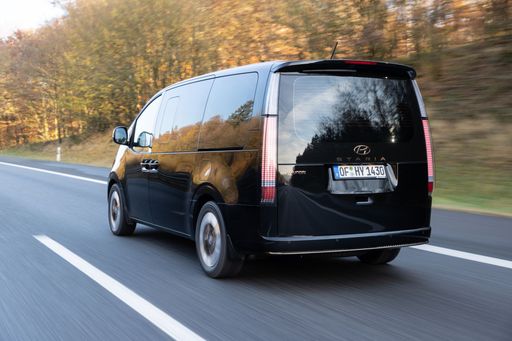 @ hyundai.news
@ hyundai.news
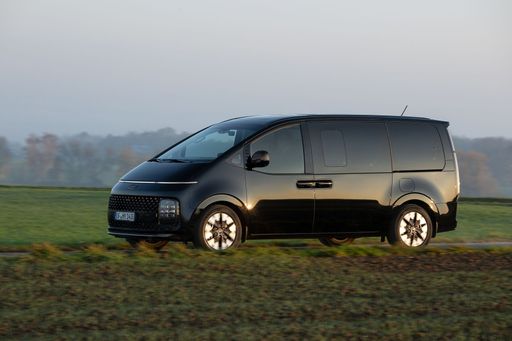 @ hyundai.news
@ hyundai.news
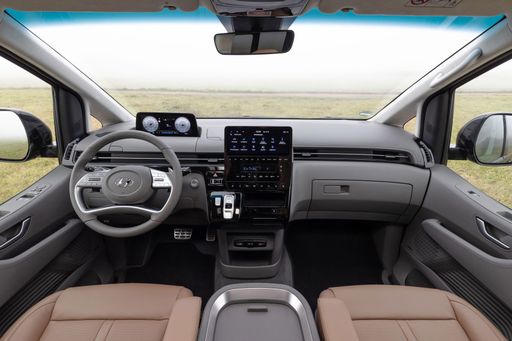 @ hyundai.news
@ hyundai.news
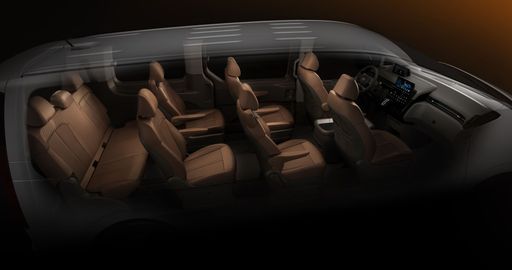 @ hyundai.news
@ hyundai.news
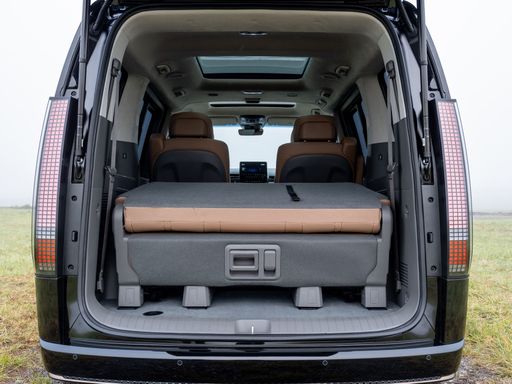 @ hyundai.news
@ hyundai.news
Mercedes V Class
The Mercedes-Benz V-Class exemplifies luxury and versatility in the world of multi-purpose vehicles. Its spacious interior is designed to accommodate both family adventures and executive travel with supreme comfort. With advanced technology and premium materials, the V-Class offers an unparalleled driving experience that seamlessly blends practicality with elegance.
details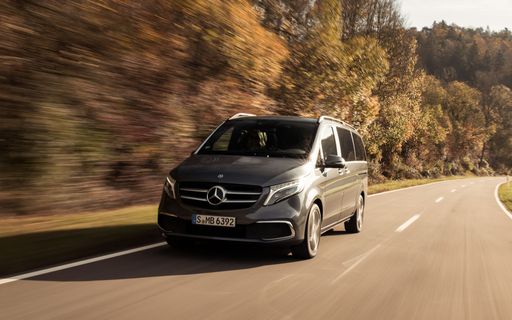 @ group-media.mercedes-benz.com
@ group-media.mercedes-benz.com
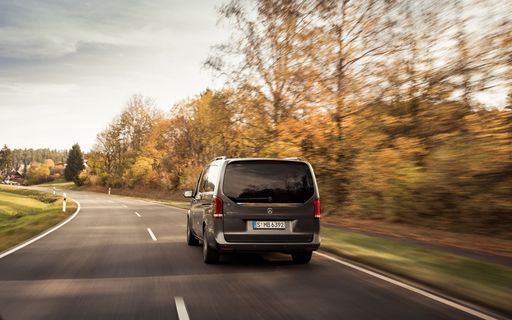 @ group-media.mercedes-benz.com
@ group-media.mercedes-benz.com
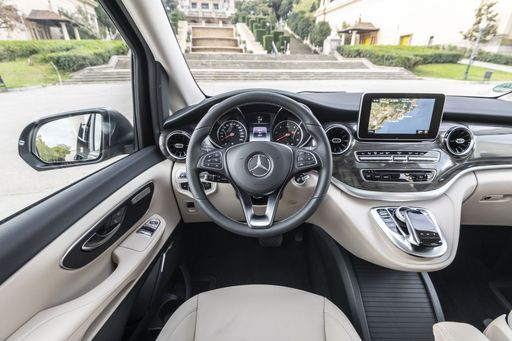 @ group-media.mercedes-benz.com
@ group-media.mercedes-benz.com
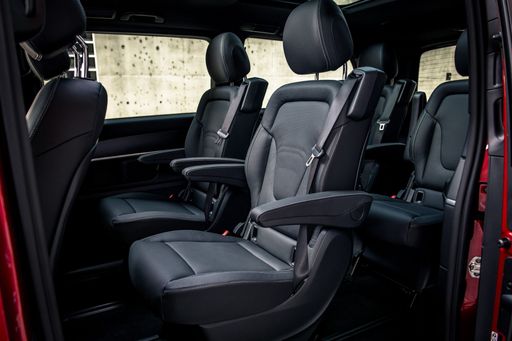 @ group-media.mercedes-benz.com
@ group-media.mercedes-benz.com

|

|
|
|
|
Costs and Consumption |
|
|---|---|
|
Price
42400 - 50500 £
|
Price
48200 - 83300 £
|
|
Consumption L/100km
7.60 L
|
Consumption L/100km
7.1 - 10.2 L
|
|
Consumption kWh/100km
-
|
Consumption kWh/100km
-
|
|
Electric Range
-
|
Electric Range
-
|
|
Battery Capacity
-
|
Battery Capacity
-
|
|
co2
172 g/km
|
co2
187 - 232 g/km
|
|
Fuel tank capacity
65 L
|
Fuel tank capacity
57 - 70 L
|
Dimensions and Body |
|
|---|---|
|
Body Type
Bus
|
Body Type
Bus
|
|
Seats
7 - 9
|
Seats
6
|
|
Doors
5
|
Doors
5
|
|
Curb weight
2275 - 2345 kg
|
Curb weight
2192 - 2464 kg
|
|
Trunk capacity
117 - 831 L
|
Trunk capacity
610 - 1410 L
|
|
Length
5253 mm
|
Length
4895 - 5370 mm
|
|
Width
1997 mm
|
Width
1928 mm
|
|
Height
1990 mm
|
Height
1901 - 1908 mm
|
|
Max trunk capacity
431 - 1303 L
|
Max trunk capacity
4200 - 5010 L
|
|
Payload
605 - 775 kg
|
Payload
636 - 908 kg
|
Engine and Performance |
|
|---|---|
|
Engine Type
Full Hybrid
|
Engine Type
Diesel, Petrol
|
|
Transmission
Automatic
|
Transmission
Automatic
|
|
Transmission Detail
Automatic Gearbox
|
Transmission Detail
Automatic Gearbox
|
|
Drive Type
Front-Wheel Drive
|
Drive Type
Rear-Wheel Drive, All-Wheel Drive
|
|
Power HP
225 HP
|
Power HP
163 - 237 HP
|
|
Acceleration 0-100km/h
10.20 s
|
Acceleration 0-100km/h
7.4 - 10.7 s
|
|
Max Speed
167 km/h
|
Max Speed
188 - 220 km/h
|
|
Torque
367 Nm
|
Torque
370 - 500 Nm
|
|
Number of Cylinders
4
|
Number of Cylinders
4
|
|
Power kW
165 kW
|
Power kW
120 - 174 kW
|
|
Engine capacity
1598 cm3
|
Engine capacity
1950 - 1999 cm3
|
General |
|
|---|---|
|
Model Year
2024
|
Model Year
2025
|
|
CO2 Efficiency Class
F
|
CO2 Efficiency Class
G
|
|
Brand
Hyundai
|
Brand
Mercedes-Benz
|
What drive types are available for the Hyundai Staria?
The Hyundai Staria is available as Front-Wheel Drive.
The prices and data displayed are estimates based on German list prices and may vary by country. This information is not legally binding.
